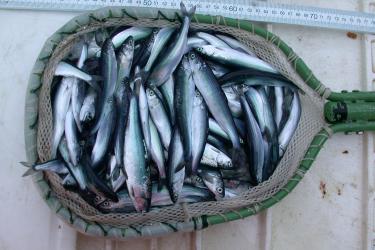Discover Some Fantastic Facts About the World’s Largest Flatfish

An Alaska Fisheries Science Center Researcher next to an Alaskan halibut. Credit: NOAA Fisheries
- An Alaskan halibut can grow to be 8 feet long and 5 feet wide, and weigh 500 pounds.
- Because of their size, adult halibut have few predators—mainly sharks, marine mammals, and humans.
- Their large size and delectable white meat make halibut a prized target for both commercial and sport fishermen, as well as an important subsistence resource. Halibut is one of Alaska’s most valuable fisheries.
- Huge halibut are called "barn doors"; small halibut are "chickens."
- "Barn door" halibut are typically females. Females grow much larger than males, which rarely reach a length of 3 feet.
- Mother halibut get more prolific as they get bigger. A 50-pound female produces about 500,000 eggs, and more eggs mean more future halibut to catch! A 250-pound female can produce 4 million eggs!
- Halibut have been getting smaller for their age since the 1970s. By the 2000s, an average 12-year-old halibut weighed half as much as one in the 1980s. The reasons for the decrease in size are unknown, but competition for food, climate effects, and fishing effects are possible causes.



